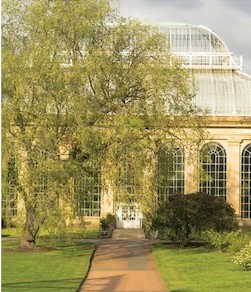Falling for Foliage
A Roundup of Magical Autumn Plants
Jerry & Giselle Lampe
WRITTEN BY CATRIONA TUDOR ERLER
Summer is waning and the garden is beginning to fade, but that doesn’t mean it can’t still pack a lot of punch. The go-to perennials for autumn color include chrysanthemums (some are more hardy than others) and asters. With a range of perennials, grasses, shrubs, and trees, you can make magic in your late-season garden. Consider adding some of the following plants to your garden this fall.
Sneezeweed (Helenium autumnale)
 |
|
The odd common name comes from the former practice of using the dried leaves for snuff. The snuff was used to induce sneezing to rid the body of evil spirits (but the plant can be toxic, so don’t try this today). The late-summer and early-fall blooms range in color from yellow to burnt orange and rust. Check out named varieties such as ‘Mardi Gras’, ‘Sahin’s Early Flowerer’, and ‘Canary’ with heights varying from 2½–5’ tall.
Aster ‘Raydon’s Favorite’ (Symphyotrichum oblongifolium var. angustatus‘Raydon’s Favorite’)
While most asters sport masses of dime-sized flowers, ‘Raydon’s Favorite’ gives you two-and-a-half times the value with quarter-sized purple-blue blossoms that cover the plant. This workhorse perennial is compact in form, growing 18–24” tall, and performs with enthusiasm in even the worst soils and weather. All these qualities earned ‘Raydon’s Favorite’ the 2016 Garden Plant of the Year award from the Garden Club of America.
 |
Monkshood (Aconitum) |
Monkshood (Aconitum; Wolf's Bane)
This old-fashioned perennial has vivid violet-blue, hooded flowers that appear in mid-autumn. An erect plant that stands 4 feet tall, its dark green leaves are palmate and deeply lobed, making a dramatic statement even when not in flower. All parts of the plant are toxic, hence the Greek name, Aconitum, which means unconquerable poison. Another common name is wolfsbane because it was used to poison wolves.
Bugbane (Actaea simplex ‘Hillside Black Beauty’, formerly Cimicifuga simplex)
The common name points to the fact that this striking plant will keep bugs at bay due to its odoriferous insect repellant properties. Visually most effective when planted in clusters, the ferny, purple- to bronze-tinted foliage grows 2½’ tall, making a striking statement all summer long. Prepare to be dazzled in September and October when the 4–6’ tall, fluffy, white flower spires shoot up from the plants, contrasting beautifully against the dark foliage. You and the butterflies will enjoy the display. The plants, which are hardy from USDA zones 4–8, prefer partial to full shade. In the Pacific Northwest, consider growing the native bugbane, Actaea elata.
Blueberry (Vaccinum spp.)
Enjoy three seasons of delight with blueberries. In spring, dainty, bell-shaped flowers hang from the branches. Later in summer, you can savor the delicious, nutrient-rich fruit (an extra bonus is if you grow them without pesticides or other poisons). In fall, the leaves turn orange, yellow, or wine red. Choose northern or southern types, depending on where you live (check with your local nursery for advice). All northern varieties have brilliant fall color; for the best color for southern varieties, opt for the V. corymbosum ‘O’Neal’ and ‘Jubilee’ hybrids. Blueberries have a wide climate range from USDA zones 5–10.
Best Native Trees & Shrubs for Autumn Foliage
Bald Cypress (Taxodium distichum), USDA zones 4–10, orange-red color, mature height 50–70’, spread 25’
Red Maple (Acer rubrum), USDA zones 3–9, red autumn foliage, mature height 40–60’, spread 40’
Black Tupelo (Nyssa sylvatica) USDA zones 3–9, fall display of various shades of yellow, orange, bright red, and purple, often on the same branch, mature height 30–50’, spread 30’
Sourwood (Oxydendrum arboreum) USDA zones 5–9 fall foliage yellow, red or even purple, mature height 25–30’, spread 20’
Sassafras (Sassafras albidum) USDA zones 4–9, deep orange, scarlet, purple, and yellow in fall, mature height 30–60’, spread 25–40’
Witch Hazel (Hamamelis virginiana), USDA zones 3–8, yellow leaves in early autumn, spidery flowers in late autumn, early winter, mature height 15–30’, spread 15–20’
Serviceberry (Amelanchier x grandiflora ‘Autumn Brilliance’), USDA zones 4–9, brilliant red to orange-red fall foliage, mature height and spread 15–25’
Chokeberry (Aronia arbutifolia), USDA zones 4–9, white apple blossom-like flowers in spring; red fruits in late summer and autumn; and brilliant orange-red fall foliage, mature height 10’, spread 6’
Sweet Gum (Liquidambar styraciflua), USDA zones 5–9, star-shaped leaves turn red, orange, and burgundy in fall, mature height 60–80’, spread 40–60’
Fothergilla (Fothergilla major), USDA zones 5–8 fragrant, white, bottlebrush-like spring flowers, warm gold and orange foliage in fall, mature height and spread 6’
•••••••••••••••••••••••••••••••••••••••••••••••••••••••••••••••••••••••••••••••••••••••••••••••••••••••••••••••••••••••••••••••••••••••••••••••••••••••••••••••••••••••••••••••
•••••••••••••••••••••••••••••••••••••••••••••••••••••••••••••••••••••••••••••••••••••••••••••••••••••••••••••••••••••••••••••••••••••••••••••••••••••••••••••••••••••••••••••••
(707)266-8086
REALTOR®
As featured in Home By Design® Magazine
Information deemed reliable but not guaranteed. All measurements are approximate. ©2019 By Design Publishing. All rights reserved.




Comments
Post a Comment